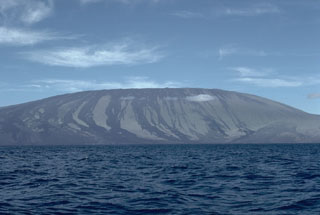Report on Wolf (Ecuador) — 4 May-10 May 2022
Smithsonian Institution / US Geological Survey
Weekly Volcanic Activity Report, 4 May-10 May 2022
Managing Editor: Sally Sennert.
Please cite this report as:
Global Volcanism Program, 2022. Report on Wolf (Ecuador) (Sennert, S, ed.). Weekly Volcanic Activity Report, 4 May-10 May 2022. Smithsonian Institution and US Geological Survey.
Wolf
Ecuador
0.02°N, 91.35°W; summit elev. 1710 m
All times are local (unless otherwise noted)
On 5 May IG reported that the eruption at Wolf’s SE flank was over. The eruption began at 2320 on 6 January from an approximately 8-km-long radial fissure, trending NW-SE, that had at least five active vents. Lava flows from the vents traveled SE then E, covering an area of more than 30 square kilometers. The maximum length of the flow field was 18.5 km, with the farthest-reaching flow stopping 150-200 m from the coastline. The highest levels of heat, sulfur dioxide emissions, seismicity, and deformation were recorded in the early days of the eruption. Sulfur dioxide emissions had been absent for the previous 30 days.
Geological Summary. Volcán Wolf, the highest volcano of the Galápagos Islands, straddles the equator at the north end of the archipelago's largest island, Isabela. The edifice has steeper slopes than most other Isabela volcanoes, reaching angles up to 35°. The summit caldera is 6 x 7 km across and 700 m deep. A prominent bench on the west side of the caldera rises 450 m above the caldera floor, much of which is covered by a lava flow erupted in 1982. Radial fissures concentrated along diffuse rift zones extend down the N, NW, and SE flanks, and submarine vents lie beyond the N and NW fissures. Similar unvegetated flows originating from a circumferential chain of spatter and scoria cones on the eastern caldera rim drape the forested flanks to the sea. The proportion of aa lava flows exceeds that of other Galápagos volcanoes. An eruption in in 1797 was the first observed and documented in the Galápagos Islands.
Source: Instituto Geofísico-Escuela Politécnica Nacional (IG-EPN)

